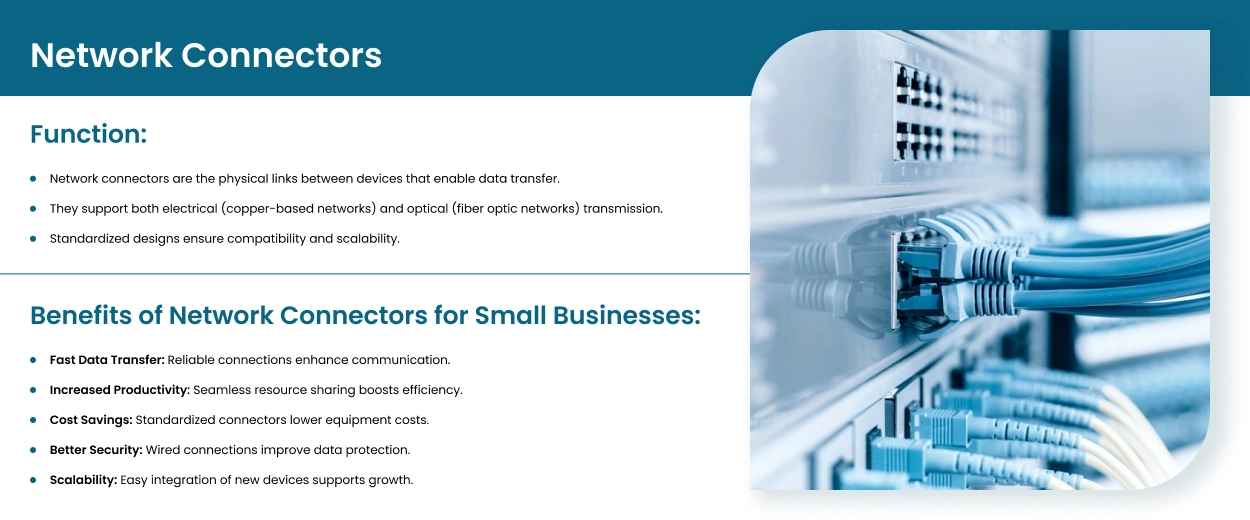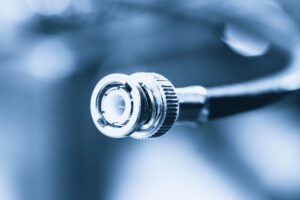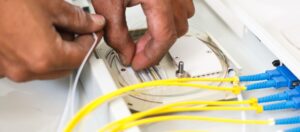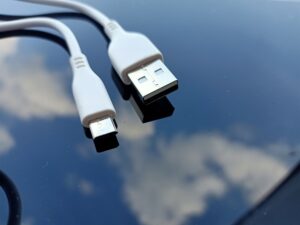"*" indicates required fields
Networking connectors are the unsung heroes of the digital age. They silently guarantee that our digital world stays linked and operational. This blog will examine networking connectors’ functions, varieties, and vital places in contemporary networking architecture. Every connector will be covered, from the actual connection to the subtleties of data encoding. The significance of networking for small businesses will also be covered, along with how they may support growth and efficiency in the digital age.
Network connectors have a variety of functions, including optical, electrical, and physical elements, that are necessary for smooth data transfer. They create safe physical connections between devices, from straightforward connectors to intricate port arrangements. Connectors electrically allow signals to be transmitted through copper wires with the least loss and interference. From an optical standpoint, they optimize performance by enabling the effective transfer of light signals in fiber optic networks. Furthermore, standardization guarantees compatibility, which fosters scalability and interoperability in networking infrastructure and makes network connectors essential to contemporary communication systems.
Network connections are the essential physical link that connects networking devices, allowing data transfer and efficient communication. They are intended to create a safe and reliable connection between devices and exist in a variety of shapes and sizes, including plugs, jacks, and ports. These connectors are vital parts of any network infrastructure since, without them, devices couldn’t communicate with one another.
A network’s ability to transmit data signals is greatly enhanced by its network connectors. They allow data to be transmitted either electrically or optically, depending on the kind of connector and the transmission medium used. Electrical connectors are frequently utilized in copper-based networks, where electrical signals travel through cables to transport data. On the other hand, light signals carry data across optical fibers with little loss or interference in fiber optic networks, which are commonly equipped with optical connectors.
Network connectors are carefully built to guarantee peak performance and dependability. Precise alignment mechanisms, robust building materials, and safe attaching features are important components of connector design. Proper alignment is essential to preserve signal integrity and lower the possibility of data loss or transmission mistakes. Strong building materials also guarantee long-term durability and safe attachment techniques stop inadvertent disconnections that can interfere with network connectivity.
Network connectors are explicitly made for certain transmission media, each of which has specific needs and features of its own. Twisted-pair copper cables, for instance, are commonly used for Ethernet connections, and connectors used in copper-based networks must support them. Similarly, optical fibers—which use light signals to transfer data—are interfaced with connectors for fiber optic networks. Network engineers can maximize performance and guarantee compatibility within their network infrastructure by matching connectors to the proper transmission medium.
Network connectors are essential not just for enabling physical connectivity but also for the encoding and decoding of data streams. They make it possible to transform digital data into electrical or optical impulses that may be sent over a network. This encoding procedure guarantees correct data transmission between devices, even in situations where there may be interference from other sources or over long distances. Network connectors add to the overall effectiveness and stability of the network by providing dependable data encoding.
Standardization is essential to ensure compatibility and interoperability between different devices and systems. Signaling protocols, electrical specs, and physical dimensions are only a few of the connector design features governed by industry standards. Fabricators can create connectors that work with various networking devices by following these standards, which facilitates smooth integration and communication across multiple network settings. Apart from that, network administrators can be sure that their infrastructure will function effectively and dependably regardless of the components they select because of standards compliance.

Networking connectors are available in a wide range of sizes, forms, and features, each designed to meet the demands and requirements of a particular networking application. All connector types, from fiber optic to Ethernet, have unique qualities and cabling uses that make them appropriate for specific transmission media and networking contexts.
In wired networking, Ethernet connectors serve as the foundation, enabling connections inside and outside local area networks (LANs). Because of its dependability and versatility, the RJ45 connector is the most used type of Ethernet connector. It has eight pins arranged in a modular socket to fit into Ethernet ports on devices like computers, routers, and switches. Stable network connections depend on their structure, guaranteeing correct alignment and secure attachment.


Broadband internet and cable television applications frequently use coaxial connectors. With the help of a metallic shield and insulating material encircling the center conductor, these connectors allow for the transmission of high-frequency signals with little interference. There are several coaxial connectors, each with a distinct design and function, such as F-type and BNC (Bayonet Neill-Concelman) connectors.
Fiber optic connectors enable light signals for high-speed data transmission over extended distances. Connectors are available in multiple varieties, including SC (Subscriber Connector), LC (Lucent Connector), and ST (Straight Tip) connectors. Each variety has distinct characteristics appropriate for particular networking settings. Fiber optic connectors make dependable and high-performing data transmission possible by providing exact alignment and connection between optical fibers.



Universal Serial Bus (USB) ports are commonly used to connect peripheral devices to computers and other electrical devices. USB connectors are flexible and convenient for a wide range of networking applications since they provide power delivery, data transfer, and device charging. Type-A, Type-B, and Type-C USB connectors are among the different sizes and forms available for these connectors; each has unique benefits and functionalities.
High-density fiber optic applications, such as data centers and telecom networks, require Multi-fiber Push-On (MPO) connectors. These connections maximize available space and streamline cable management by allowing several fibers to connect at once. The push-pull locking mechanism of MPO connectors offers a reliable and safe connection for data transfer.



Connecting computers, gaming consoles, and televisions are just a few audiovisual applications that frequently use High-Definition Multimedia Interface (HDMI) ports. HDMI connectors support high-definition audio and video transmissions, making multimedia networking possible. Standard HDMI, Mini HDMI, and Micro HDMI connectors are among the different varieties available; each is designed for a particular device or set of uses.
Network Drops provides a wide range of services for companies looking for dependable networking solutions, such as network design, installation, and maintenance. Our proficiency and commitment to client satisfaction guarantee uninterrupted connectivity and peak performance for your company’s activities. Network Drops offers the expertise to handle your networking needs, whether upgrading your current infrastructure or creating a new workplace network.
In summary, networking connections enable smooth communication and data transmission across various devices and situations, making them the unsung heroes of modern connectivity. Businesses can take advantage of connectivity’s potential to stimulate innovation, efficiency, and growth in the digital age by comprehending the nuances of connectors and their function in networking architecture. A variety of connector types, including fiber optic and Ethernet cables, make possible the linked society we live in today.
Ethernet networking primarily relies on RJ45 connectors for wired connections and transceivers for fiber optic connections. RJ45 connectors ensure seamless communication within LANs and beyond, providing a reliable physical connection for data transmission.
Networking cables come in various forms, including twisted-pair copper cables (e.g., Cat5e, Cat6), coaxial cables, and fiber optic cables. Each cable type has advantages and limitations, catering to different networking requirements and environments.
Terminating a network connector involves carefully stripping the cable, arranging the wires according to the wiring standard (e.g., T568A or T568B), and crimping the connector onto the cable using a specialized tool. Proper termination is crucial for ensuring optimal signal transmission and network performance.
Fiber optic connectors offer several advantages over traditional copper-based connectors, including higher bandwidth, lower signal loss, and immunity to electromagnetic interference. These benefits make fiber optic connectors ideal for high-speed and long-distance networking applications like data centers and telecommunications networks.
Connectors play a vital role in establishing reliable network connections and facilitating seamless communication, data transfer, and employee collaboration. By investing in quality connectors and networking infrastructure, small businesses can enhance productivity, streamline operations, and support growth objectives.
Scott Fcasni is the driving force behind Shock I.T. Support’s commercial datacomm cabling division, delivering expert solutions that power reliable, high-performance network infrastructures. With extensive experience in structured cabling and a commitment to precision, Scott ensures that every project—whether for small businesses or large enterprises—meets the highest standards of quality and scalability.